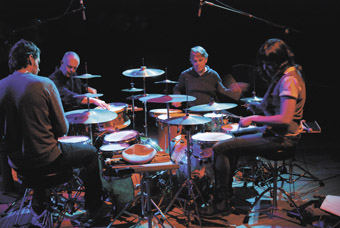from the outside in
felicity clark: synergy percussion with fritz hauser

Synergy with Fritz Hauser
photo Timothy Constable
Synergy with Fritz Hauser
The stage is set theatrically with clusters of percussive objects prophesying scenes to come in Synergy’s Space and Time program. Desks in each corner are cloaked in black sateen sheets heightening the sense of mystery about the shapes they conceal.
Percussionists Michael Askill, Timothy Constable, Bree van Reyk and Swiss guest artist Fritz Hauser take the stage quietly and directly, sitting straight-backed at their desks beneath harsh straw light. Their measured dispassion suggests the professional legitimacy of the artisan and forecasts a performance of unobtrusive depth.
Beginning as whispers, their clicks, taps, twangs and chinks build as the players strike their hidden instruments. Hauser channels seemingly African ostinati while Askill explores timbres of timber. Van Reyk shuffles beads until Constable signals them all into a frenzied unison and stop.
With silence comes darkness on all but Hauser who continues to forage for fresher combinations of sound. His every move is free and flowing yet completely controlled, yielding the precise result of the intent written in his brow. A subtle sense of the outsider is established between Hauser and Synergy that prevails for much of the evening.
While the visitor captivates the audience, Synergy’s players move to a nest of four inward facing drum-kits. Later, Hauser joins them, sharing their offering, then making it his own as the trio move forward to a set of Himalayan bells shaped like bronze bowls.
The bells rest on right hands while left hands circle the rims with wooden pestles. The continuous actions yield a sustained ringing and, for the first time in the improvised program, harmonic relationships surface. Consonance and dissonance merge in and out, pulsing like the pain I imagine in the kneeling percussionists’ feet. Again Hauser joins them only to diverge musically, taking the audience’s attention in tow.
When lights dim to end the concert’s first half, Synergy’s signature backdrop of Asian gongs waits patiently behind a stocky wooden table covered in metal artefacts promising different dramas to come.
When we return for the second half, the black cloths have been stripped from the desks. In a domestic tease Askill scrapes a cymbal as though scouring a dirty pot; Van Reyk slows the tap of rubber mallets on wood, enacting a bouncing ball’s eventual submission to gravity. Constable adds the twitter of a mobile phone, a doorbell and the twirl of a tiny ballerina in a music box on miniature piano. Incidental, everyday noises become the focus of Synergy’s improvisation, an idea completed back at their desks by Constable evoking an electronic key-finder on several pitched wood blocks. In an esoteric program these signposts are easy to latch onto; while risking the kitsch-factor they involve listeners where the monotones of ever-evolving sonic scaffolds can sometimes alienate.
Integrating the two halves, snippets of vocal material from the first are revoiced in the second by sound designer Bob Scott. Seated at the centre of the front row, he is the fifth musician, applying effects and sculpting the others’ efforts. Also marrying halves, the notion of the outsider is take up again when members of Synergy take turns as the autonomous outcast. While three players let one musical exploration wane, Van Reyk treads timely to the lurking gongs and asserts her presence by singing into them.
Sounds produced by Fritz Hauser’s mallets and sticks independently of drums and cymbals eclipse momentarily the whole gamut of sound being fashioned by Synergy. At times his brushes whoosh through the air—electrifying the space between sounds. Hauser’s cymbal scratching challenges the very basics of percussive perception.
The definitive quality of percussion instruments as opposed to melodic ones is that the sounds are made with noticeable attack and rapid decay. If sustained sound is required, the percussionist must repeatedly hit the instrument or object to give the impression of continuous sound. Most commonly, this involves lifting the stick, hand or other appendage and dropping or throwing it down onto the instrument. Hauser contradicts this vertical approach by utilizing a horizontal spectrum of movements. He shakes our expectations of duration by developing an idea such as scuffing to a point where the listener must find interest in infinitesimally small fluctuations in momentum and direction.
Hauser’s inventiveness and acute responsiveness to Synergy Percussion’s stimuli make him one of them and, equally, set him apart. Together, the wholly accomplished and charismatic Synergy has produced another captivating and, in this case, theatrical performance with a distinctly Australian essence.
Synergy Percussion with Fritz Hauser, Space and Time, performers Michael Askill, Fritz Hauser, Timothy Constable and Bree van Reyk, live electronics, sound design Bob Scott, lighting Neil Simpson; CarriageWorks, Sydney June 27-28
RealTime issue #86 Aug-Sept 2008 pg. web






